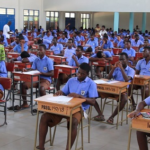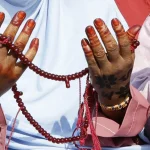Artificial turf also referred to as astro turf is a synthetic surface that is made to look like real grass.
It is used in sports arenas, depicted as residential lawns, and commercial applications that traditionally use grass.
It is much more durable than grass and easily maintained without irrigation or trimming, although periodic cleaning is required.
Today, the most common type of artificial turf used is referred to as third-generation turf. The third-generation turf has a few different layers. The bottom layer is either a gravel, asphalt, or concrete base.
Sometimes a shock-absorbing pad is placed on top of the base. Next is the turf itself, which is made of pile fibres that look like grass.
Finally, silica sand and/or tiny rubber pellets are used to fill in the space between the fibres.
This is called the infill and the amount of infill can vary between fields.
Artificial turf has become a popular choice for sports fields across Ghana but is increasingly controversial.
On November 29, 2023, Vice President Dr Mahamudu Bawumia at the launch of the 100-day countdown to the 13th African Games, Accra, emphasized the government’s commitment to sports infrastructure development, highlighting the significant investments made at both the national and community levels.
Dr. Bawumia highlighted the government’s investment in community-level sports facilities, particularly the construction of 153 astro turfs across the country.
He emphasized that this initiative is about creating quality sports facilities that are accessible to the grassroots due to proximity, fostering the development of sports in Ghana.
The Minister for Youth and Sports, Mustapha Yussif, during his press briefing in Accra on March 4, 2024, admonished the media to rally behind the government to make the African games a success.
At the back of this, he detailed the total cost of infrastructure for the games, which, according to the Minister, is $195 million – Borteyman complex: $145 million; University of Ghana: $34 million; Games Village: $16 million. These transactions came with no thorough thought to marketing.
With a day until the opening ceremony of the 2023 African Games, the success of the African Games hinges not only on the completion of essential infrastructure but also on proactive measures to maintain these facilities, especially football pitches for colts football and young footballers.
But, how accessible are these astro turfs to grassroots and community football talents?
These turfs are mostly built on community parks entrusted in the care of district authorities or community leaders.
This makes it difficult for football talents to use the facility because they are not just a normal football park.
These astro turfs are most often hired out to corporate institutions and organizations whose activities are outlandish to the artificial pitches. The misplaced use of such facilities is due to the neglect of natural denizens as sports.
Even, astro turfs could have been training grounds for colts football, their presence of which must lure raw talents in the nooks and crannies to developed centres for their training.
An opportunity to turn away from small, brown pitches in the open spaces or compounds in houses.
This is due to the neglect of community football like colts football who can’t access these pitches for their development.
Many Ghanaians believe this neglect has contributed to the woeful performances of our youth teams at tournaments in recent times.
Worldwide, especially in African football, strikers have groomed themselves at the grassroots level before being identified for progression.
The unavailability of designated spaces where young upstarts may train and build themselves up is a handicap to the possibilities under their sleeves.
Gravel, asphalt, or concrete base in astro turfs against injuries
A study from the NFL Players Association in America between 2015 and 2022 found higher injury rates on artificial turf every season.
It showed a higher rate of foot and ankle injuries on artificial turf, both old-generation and new-generation turf, compared with natural grass.
High-quality studies also suggest that the rates of knee injuries and hip injuries are similar between playing surfaces, although elite-level football athletes may be more predisposed to knee injuries on artificial turf compared with natural grass.
Severity and recovery rate of injuries
Something else to consider when evaluating artificial turf versus natural grass injuries is the severity of each injury. A study published in 2022 evaluated English professional rugby players’ injuries on natural grass, artificial turf, and a hybrid that combined the two.
They found that injuries sustained on artificial turf fields were more severe than injuries on a natural grass field or a hybrid field.
They concluded that, on average, injuries on artificial turf fields took longer to recover from than grass field injuries.
This analysis adds important information indicating that these injuries are more common on artificial turf, but they are also more serious.
It is also said that as artificial turf has become popular for school and community fields, it has become less popular for professional sports fields because of injuries.
Ankle injuries, concussions, heat-related illness and injury, and abrasions, all of which may occur more frequently on artificial turf than grass.
The study also indicated that ankle sprain was the most common injury and occurred at a rate of 1.5 injuries per 1000 hours of playtime on artificial turf compared to 0.8 injuries per 1000 hours on natural grass.
Researchers who studied professional male soccer players throughout 4 Major League Soccer seasons found an even greater increase in injuries.
They found that the rate of Achilles injury was twice as high on turf as it was on grass and the rate of ankle fracture was 6 times as high on turf compared to natural grass.
Where NFL players are getting injured, based on field type and body part.
| Head | 0.76 | 0.90 | +0.14 |
|---|---|---|---|
| Ankle or foot | 0.96 | 1.05 | +0.09 |
| Shoulder | 0.39 | 0.42 | +0.03 |
| Core | 0.34 | 0.37 | +0.03 |
| Arm or hand | 0.42 | 0.43 | +0.01 |
| Upper legs and hips | 0.46 | 0.46 | ±0.00 |
| Lower legs and knee | 1.25 | 1.23 | −0.02 |
The bottom line
Many studies have examined injury rates on artificial turf versus grass.
In many cases, injury rates are greater on artificial turf. Injuries are not the only risks associated with artificial turf. There are also concerns regarding the chemicals found in artificial turf infill.
Infill varies, with greater concerns about rubber mulch, silica, and other infill that breaks down to particulate matter that can get into the lungs.
These infills may be used for sports fields as well as playgrounds, putting young children at risk of harmful side effects.
The average cost of astroturfs has been between Gh¢300,000 and Gh¢600,000, according to the Public Interest and Accountability Committee(PIAC).
However, these funds can be channelled into upgrading our community grass pitches to unearth our talented footballers.
Killing their careers before they even start would be a big loss to a football nation like Ghana.














